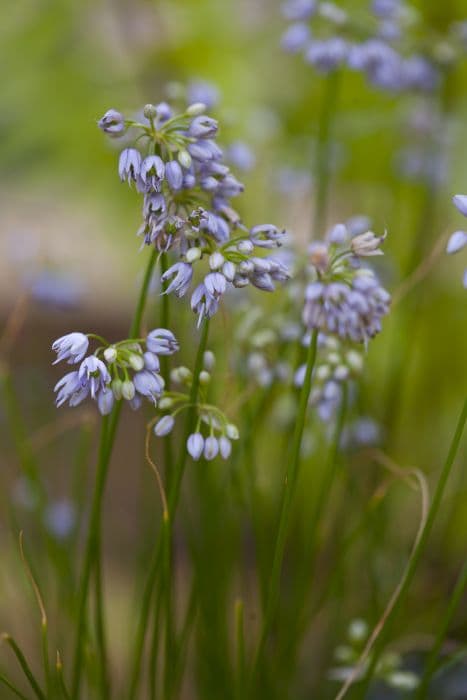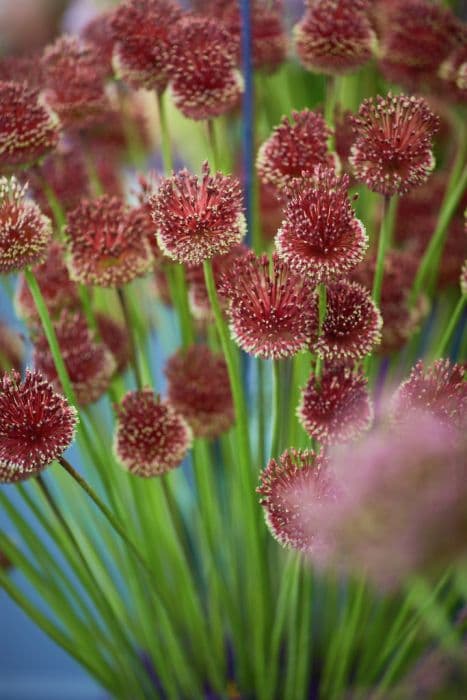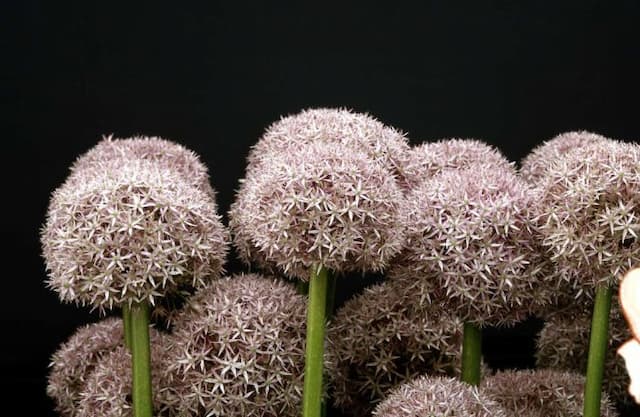Sikkim Onion Allium sikkimense

ABOUT
Allium sikkimense, commonly known as Sikkim onion, is a perennial plant characterized by a neat growth habit with slender, tubular leaves that emerge from a bulb at the base. The foliage is typically a lush green, contributing to the plant's grass-like appearance. During its blooming period, the Sikkim onion produces striking spherical clusters of flowers. These flowers are arranged on top of a long, leafless stem, known as a scape, which elegantly rises above the foliage. The blooms can be described as a collection of small, individual star-shaped flowers that together form a globular umbel. Each flower is usually a shade of blue to purple, giving the floral sphere a captivating appearance that is appealing to both gardeners and pollinators alike. After blooming, the flowers give way to seed capsules which can also present an ornamental value to the overall look of the plant. The Sikkim onion, with its attractive flowers and neat foliage, is often used in ornamental gardening to create visual interest and to attract beneficial insects.
About this plant
 Names
NamesFamily
Amaryllidaceae
Synonyms
Sikkim Onion
Common names
Allium sikkimense
 Toxicity
ToxicityTo humans
Allium sikkimense, commonly known as Sikkim onion, is not typically considered toxic to humans. In general, plants in the Allium genus, which includes onions, garlic, leeks, and chives, are edible and widely used in cooking. However, individuals with certain sensitivities or allergies to Allium species may experience adverse reactions from handling or consuming this plant.
To pets
Sikkim onion, like other members of the Allium genus, can be toxic to pets, particularly cats and dogs. The ingestion of Allium sikkimense can lead to symptoms such as gastrointestinal upset, lethargy, abdominal pain, and in severe cases, hemolytic anemia, which is the destruction of red blood cells. Signs of poisoning might include vomiting, diarrhea, weakness, and a decreased appetite. If a pet consumes a large quantity of the plant, it could result in more serious conditions requiring veterinary attention.
 Characteristics
CharacteristicsLife cycle
Perennials
Foliage type
Deciduous
Color of leaves
Green
Flower color
Blue
Height
1 feet (0.3 meters)
Spread
0.5 feet (0.15 meters)
Plant type
Bulb
Hardiness zones
4
Native area
Asia
Benefits
 General Benefits
General Benefits- Culinary use: Allium sikkimense, commonly known as the Sikkim chive, has edible leaves and bulbs that are often used in cooking for their flavor.
- Ornamental value: With its attractive flowers and foliage, Sikkim chive can be used to beautify gardens and landscapes.
- Pollinator attraction: The flowers of Allium sikkimense attract bees and other pollinators, supporting biodiversity.
- Easy to grow: Sikkim chive is known for being low-maintenance and easy to cultivate, making it suitable for gardeners of all skill levels.
- Edible landscaping: Allium sikkimense can be used in edible landscaping, where the aesthetic beauty of a garden and food production are combined.
- Cultural significance: In some regions, it holds cultural importance and is often used in traditional ceremonies or dishes.
 Medical Properties
Medical Properties- This plant is not used for medical purposes.
 Air-purifying Qualities
Air-purifying QualitiesThis plant is not specifically known for air purifying qualities.
 Other Uses
Other Uses- Allium sikkimense, commonly known as Sikkim onion, can be used to create a natural dye for fabrics, with different parts of the plant producing different shades.
- The dried plant material may serve as an addition to potpourri mixes, contributing its unique scent and texture.
- The strong scent of Sikkim onion leaves can deter certain insects and pests in the garden when planted as a companion plant.
- Sikkim onion can be used in floral arrangements, where both the flowers and seed heads provide an aesthetic appeal.
- With their distinctive look, the round clusters of star-shaped flowers can be used for ornamental crafts such as dried flower boutonnieres.
- Seed heads of the Sikkim onion can be used in decorative wreaths, adding a natural and rustic touch to home decor.
- Pressed flowers and leaves of the Sikkim onion can be incorporated into botanical art and herbarium collections for educational purposes.
- Photographers and artists may use the striking appearance of Sikkim onion's blooms as a subject for botanical photography and paintings.
- The fibrous leaves can be utilized in weaving small-scale, decorative items like bookmarks or coasters for ecological art projects.
- When allowed to bolt, the tall and sturdy stems of Sikkim onion can be used as natural stakes for supporting other, more delicate plants in the garden.
Interesting Facts
 Feng Shui
Feng ShuiThe plant Allium sikkimense is not used in Feng Shui practice.
 Zodiac Sign Compitability
Zodiac Sign CompitabilityThe plant Allium sikkimense is not used in astrology practice.
 Plant Symbolism
Plant Symbolism- Unity: Much like other members of the Allium family (e.g., onions, garlic), the Blue Himalayan Onion's (Allium sikkimense) clustered blossoms can represent unity, as the individual flowers come together to form a single spherical umbel.
- Humility: Their modest height and delicate flowers can be seen as a symbol of humility, a contrast to more ostentatious blooms.
- Patience and Perseverance: The plant's ability to grow in rocky, inhospitable environments of the Himalayas can symbolize the virtues of patience and perseverance through challenging conditions.
- Prosperity and Abundance: In some cultures, Alliums are believed to bring luck and signify prosperity and abundance, owing to their lush, full flowerheads.
- Protection: Historically, Allium species have been thought to have protective qualities, believed to ward off evil spirits and negative energies.
 Water
WaterSikkim onion prefers well-drained soil and does not like to be waterlogged. Water the plant once a week with about 1 inch of water, ensuring to soak the soil thoroughly. During the growing season in spring and summer, maintain consistent moisture, but reduce watering during the dormant period in the winter. If rainfall is adequate, you may not need to water at all. Always check the soil before watering; if the top inch feels dry, it is time to water again. Be mindful not to over-water, as this can lead to bulb rot.
 Light
LightSikkim onion thrives best in full sunlight but can tolerate partial shade. The ideal location is a spot where the plant receives at least 6 hours of direct sunlight each day. Avoid deep shade, as this can impede growth and reduce flowering. An east or west-facing garden bed or border that receives plenty of light throughout the day is ideal for this plant.
 Temperature
TemperatureSikkim onion grows well in temperatures between 55°F and 75°F. It can tolerate a minimum temperature down to about 20°F, making it suitable for hardiness zones 4 through 9. The plant enjoys cooler conditions and may enter dormancy if temperatures rise significantly above the ideal range. Protecting the bulbs with mulch in winter can help insulate them from extreme cold.
 Pruning
PruningSikkim onion requires minimal pruning. Deadheading spent flowers after blooming encourages the plant to focus energy on bulb growth rather than seed production. However, if you wish to collect seeds, leave some flower heads intact. Cut back the foliage only after it has died down naturally in the fall, which helps provide nutrients back to the bulb for the next growing season. Pruning is not regularly necessary beyond these practices unless removing damaged or diseased leaves.
 Cleaning
CleaningAs needed
 Soil
SoilSikkim onion thrives in well-drained soil with a mix of loam, sharp sand, and compost. An ideal pH range for this plant is between 6.0 and 7.5.
 Repotting
RepottingSikkim onion should be repotted every two to three years to refresh the soil and accommodate bulb growth.
 Humidity & Misting
Humidity & MistingSikkim onion prefers moderate humidity levels but is quite adaptable to different humidity conditions as long as there's good air circulation.
 Suitable locations
Suitable locationsIndoor
Ensure bright light, cool temperatures and well-drained soil for indoor Sikkim onion.
Outdoor
Plant in full sun to part shade, well-drained soil, and protect from harsh weather.
Hardiness zone
4-9 USDA
 Life cycle
Life cycleAllium sikkimense, known as Sikkim onion, begins its life cycle when a seed germinates in moist, well-draining soil, typically in a cool, temperate climate. The seedling emerges with a initial set of leaves and develops a bulb as it matures. As it grows, more leaves appear and the bulb enlarges, storing nutrients for the plant. Upon reaching maturity, the Sikkim onion produces a tall stem with an umbel of star-shaped blue or purple flowers, usually in late spring or early summer. After pollination, possibly by insects such as bees, the flowers develop into capsules that contain seeds. The plant then goes into a period of dormancy, especially in colder climates, where the bulb remains dormant underground through the winter until the next growing season begins.
 Propogation
PropogationPropogation time
Spring to summer
Allium sikkimense, commonly known as Sikkim onion, is often propagated by seed. The most popular method of propagation for this species is by sowing seeds directly in the garden after the danger of frost has passed. In regions with mild winters, seeds can be planted in autumn. However, sowing in spring often results in a more successful germination due to stable temperatures. To ensure even growth, seeds should be sown in well-draining soil and barely covered with dirt; they require some light to germinate. Seedlings typically emerge within 3 to 4 weeks. Once seedlings have grown enough to handle, they should be thinned to about 4 to 6 inches (approximately 10 to 15 cm) apart to allow for proper bulb development.









